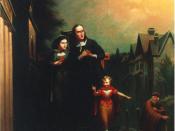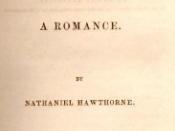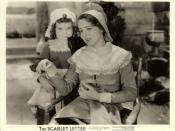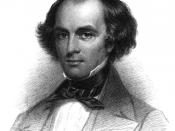Notebook Topics: The Scarlet Letter 1. The voice of the story is told through Hawthorne's experience with his ancestry and the people he observed in his lifetime. We know this by the introduction to the story where he describes the scarlet letter he found when he worked in the Custom House. At that time he met many people who would be character studies for his novel. However, the characters are fiction, their actions advance the plot in three separate events all revolving around Hester, the main character, who is found guilty of adultery. She must stand in front of the entire town on a scaffold for hours with the scarlet letter sewed on her dress. The scaffold becomes the place of action in the major shifts in the plot. The argument is made against hypocrisy, a sin much worse than adultery. Hawthorne does this masterfully by presenting the overly religious as blind to human nature, he contrasts Hester as a figure larger than life, refusing to submit to guilt throughout the story.
As a result of her strength and her refusal to acknowledge her partner in sin, the other characters are brought into the light of their own hypocrisy.
2. The main conflict is framed through the punishment of Hester for adultery and her partner, Dimmesdale, who she refuses to confess to the state. The great hypocrisy is the fact that he is a Puritan minister, the representative of God's judgement, yet he never confesses until he is riddled with shame at the very end. Further conflict is found with her husband, Dr. Chillingworth, who tortures Dimmesdale for his unconfessed sin. Also through the bastard child Pearl and her fascination with the scarlet letter. Also, the people who have created a living hell for them are seen as conflicting with the main character. The historical context of this story is the real life suffering caused by the persecution of the innocent women in Salem during the 16th century. The author uses real names in the story, as if he were trying to make amends for his ancestors who were involved in the "Salem Trials" which frames the major theme of the story""hypocrisy. The answers Hawthorne lays out for readers are mired in vagueness. However, it is clear that a strict society that ignores human faults will be remembered for its narrow mindedness and the suffering it caused rather than for its compassion.
3. The main context of the story is set in Puritanical New England in the 1600's. The historical significance of that period of time features heavily on the author, a direct ancestor of the Puritans. Sexual conduct and patriarchy greatly affect the characters. The men are depicted as cowardly while the protagonist is depicted as larger than life, refusing to give in to a system she feels is wrong. When she is tried and found guilty, she never hides her face or shows emotion. She even stitches her bright crimson letter "A" with gold stitching so that it will stand out against the drab dress of the times. The effect of the harsh environment of Puritanism lasts throughout the story causing guilt, depression and fear amongst the main characters. In the final episode, when Dimmesdale stands on the scaffold with Hester and Pearl and tells the town people the horrible secret he has kept inside himself for so long, the story finally shifts to a place of light and freedom. Hester must escape the country to live in freedom, then to return years later as a folk hero. Hawthorne demonstrates the horrible crime of hypocrisy and how it eats away at the very nature of human behavior.
4. The work itself is a timeless classic, its setting is dark which frames the protagonist in an angelic light despite her hardships. The genre is symbolic tragedy. Throughout the story, beginning with the symbolism of the title, the author uses this literary device to imply meaning rather that preach it directly. The result is a beautiful analysis of the strengths and weakness of the human spirit and the power religion has on the daily lives of ordinary people. Hawthorne adorns meaning in his brilliant use of language and the names of his characters. Chillingworth implies coldness while Pearl implies something precious that is born in chaos. Symbolic are the settings such as the prison in the beginning and the darkness that surrounds Boston in every description until Hester leaves with her husband. The author's brilliant ability to use language goes deep into the heart of the reader, spanning both time and cultural history, giving a sense of unity to the story as a message for the human race""He who forgets the past is doomed to repeat it!





